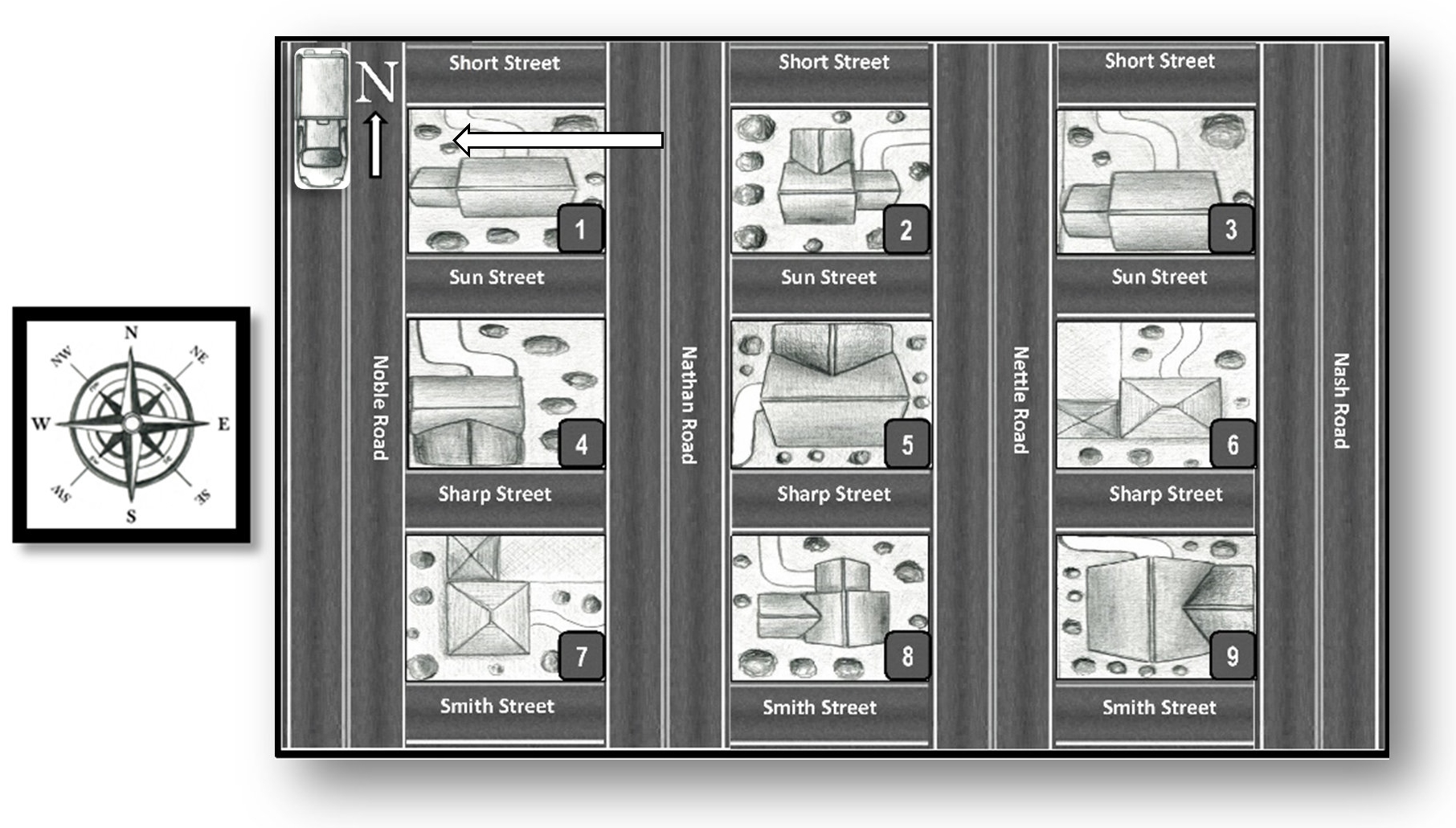Working Memory Tasks

Working Memory Tasks: This webpage is dedicated to providing readers with an insight into how to best use the following directions exercises from chapter 5, featured in the Working Memory Challenges book. The clinician demonstrates how to encourage and facilitate students' oral receptive and expressive language skills using scaffolded support.
Scaffolding is an essential language learning method that provides the necessary structure for a student to learn a new language concept or skill.
Working Memory Task - Street Directions
Following Directions - Street Directions: Activity A
The following directions chapter features three separate but related scenarios, beginning with 5 entry level scenarios then 5 intermediate level scenarios (in terms of language complexity) and concluding with 5 advanced level scenarios.
The following example is taken from the entry level scenario that begins the chapter. Chapter 5 includes a detailed tutorial, which our example student completed prior to attempting the activities.
Activity 1A: 1. Place the small van to the left of building 7 at the bottom of the road pointing north.
Clinician: "Place the small van to the left of building 7 at the bottom of the road pointing north.“
There is quite a bit of information to process in this command. The student selects the correct van but places the van at the top end of Noble Road adjacent to building 1, pointing south. So it is possible that the student was unable to fully process all of the multi-step instruction.
The clinician makes a note of the student's error in the placement of the van and then repeats the instruction. This time however scaffolded support is provided by the clinician in this working memory task.
Note
that the small van has been placed incorrectly by the student. The van points
south and is to the left of building 1, not building 7. The compass was placed
next to the street map prior to the oral instruction by the clinician.
Clinician: “It’s great that you selected the small van and
it is on the correct road. But you have placed the van so that it points
south, not north. And there was also something about building 7. Look
where the van is positioned. Is it near building 7?”
Student: “Oh, the van needs to be down
here.”
The student removes the van from beside building 1
and places it near building 7 on Noble Road. The van is still pointing
south at this stage.
Clinician: “Great, the van is certainly in the right area
now. But there is still a minor problem in that the van is pointing south.
Let’s have a look at the compass.”
Clinician: “We can see on the compass that the van is
certainly pointing south. The directions state that the van needs to be
pointing north. What should we do with the van?”
Student: “It need to turn around.”
The student turns the van so that it points north.
The clinician then repeats the directions while the student checks the
positioning of the van to ensure that it points in the correct direction and
that its position on the board is suitable for the next direction in the
sequence of instructions on this particular working memory task.
Activity
1A: 2. Move the van forward 50 meters.
Clinician: "Move the van forward 50 meters.'
The student is supplied with a specific ruler
that is a feature of the program and positions it next to the van.

The ruler measures two distances - 50 meters and 100 meters and has been designed to correspond with the distance between streets running horizontally on the street map.
The student, with guidance from the clinician, is able to correctly move the van 50 meters north.
Activity 1A: 3. Turn right into the street (Sharp Street).
Clinician: "Turn right into the street."
Given the absence of turn choices in this sequence, this is a fairly easy instruction to follow. The student correctly turns the van into Sharp Street.
Activity 1A: 4. Move the van forward to the end of the street and stop.
Clinician: "Move the van forward to the end of the street and stop."
The student moves the van forward but fails to stop
at the end of the street but continues on past the next highway and enters the
next street. The clinician instructs the student that the van needs to stop at
the end of the street and not cross the highway (Nathan Road).

To complete the sequence the clinician reads from the text, "The van should be positioned just below building 4, pointing west."
Working Memory Task - Placing Furniture
Following Directions - Furniture Placement: Activity B
After completing the street directions activity the
clinician exchanges the street map for the house layout board in order
to complete this working memory task. The clinician helps the student identify
each of the rooms before the activity begins.

Activity 1B: 1. Lift from the van the pot plant, the patterned rug and the T.V.
Clinician: "Ok, the van has found the correct address. It now needs to deliver the furniture. Lift from the van the pot plant, the patterned rug and the T.V."
There are 14 furniture items used in the placing furniture activities. The clinician chooses 6 of the items, 3 of the items are the pot plant, the patterned rug and the T.V., and arranges them in a line. The student correctly selects the 3 named items in this working memory task.
Activity 1B: 2. Place the patterned rug lengthways in the middle of the dining room.
Clinician: "Place the patterned rug lengthways in the middle of the dining room."
The student is required to sort through 3 pieces of
information while searching for the correct room. The student correctly selects
the patterned rug and places it in the dining room. However, the rug is
positioned incorrectly near the left wall of the dining room. The
clinician repeats the instruction and adds some extra scaffolding to the
instruction.

Clinician: "You have placed rug in the correct room and have placed it lengthways. But listen again, Place the patterned rug lengthways in the middle (underlined words given emphasis) of the dining room."
The student having listened carefully re-positions the rug so that it is positioned in the middle of the dining room.
Activity 1B: 3. Place the pot plant in the bottom left corner of the lounge room.
Clinician: "Place the pot plant in the bottom left corner of the lounge room."
The student places the pot plant correctly in the bottom left corner of the lounge room.
Activity 1B: 4. Place the T.V. in the top left corner of the lounge room.
Clinician: "Place the T.V. in the top left corner of the lounge room."
The student incorrectly places the T.V. in
the top right corner of the dining room not the top left
corner as instructed. The clinician repeats the instruction to the student but
adds extra scaffolding to this working memory task. The student completes the
activity successfully.

A view of the correctly completed sequence. The student with some scaffolding provided by the clinician has correctly place 3 furniture items in the house.
Working Memory Task - Recall of Details
Following Directions - Recall of Details: Activity C
Street Directions Recall
During the recall of details activity the student is encouraged to visualize the sequence of events that occurred in the street directions and placing furniture sequences. The concluding following directions activity, activity C, begins with the clinician first removing the street map and house layout boards. The recall of details section prompts students verbal working memory skills. For the recall activity, encourage students to visualize the sequence of events that occurred with the positioning of the van/s and furniture items in activities 1A and 1B.
Activity 1C: 1. Which van was used in this activity?
The clinician reads the question and the student correctly recalls that it was the small van used in following directions activity 1A.
Activity 1C: 2. How far did the van travel on the road before turning?
Clinician: "This question asks for specific information. Think back to when you used the ruler to measure the distance the van had to travel."
Student: "It was 50 meters."
Activity 1C: 3. Did the van turn left or right into the street?
The question gives the student a relatively simple choice and contrast question that the student has little difficulty answering. This working memory task becomes significantly more challenging when students are required to visually recall the van's position relative to it pointing either north or south (essentially upside down) as happens in the intermediate and advanced sections of the following directions activity.
Activity 1C: 4. At which house number did the van stop?
The student initially has difficulty responding to this question so the clinician provides more scaffolding.
Clinician: "Think about the houses are arranged with house number 1 being in the top left of the board and the houses are in a line of 3 across. So if we go to the next line down from the top row we have the middle row. First number directly after 3 must be...?"
A simple cloze procedure allows the student to fill in the missing piece without the clinician providing the answer.
Student: "Number 4."
Clinician: "Number 4 is correct. Well done."
Placing Furniture Recall
Activity 1C: 1. Were any of the items placed in the bedrooms?
Clinician: "Do you remember if any of the items were placed in the bedrooms?"
This is a relatively simple question. The student indeed remembers that none of the furniture items were placed in the bedrooms and is able to answer correctly without extra scaffolding being required.
Activity 1C: 2. Was the pot plant placed in the lounge room or the hall?
Clinician: "Was the pot plant placed in the lounge room or the hall?"
This question requires the student to choose between 2 areas of the house layout. The student is able to quickly recall that an item was placed in the lounge room and names the pot plant.
Activity 1C: 3. What item was placed in the lounge room?
Clinician: "What item was placed in the dining room?"
This is a direct question and is slightly more difficult than the questions which precede it. It requires the student to visualize exactly which item was placed in the dining room. The question also requires the student to recognise the difference between the dining room and the lounge room and understand that they are separate areas of the house.
Student: "Was it the T.V.?"
Clinician: "No it was the rug and it was placed in the dining room. The dining room is above the lounge room and the rug was placed in the centre of the room."
Activity 1C: 4. Where was the T.V. placed?
This questions requires a specific response from
the student. The student is required to provide the specific location
of the T.V. The student correctly identifies that the T.V. is in the lounge
room but doesn't state the exact location. The clinician makes a note of this
and decides to target the student's verbal recall for the next working memory
task.
Return from Working Memory Task to Working Memory Challenges
Updated 07/2017
